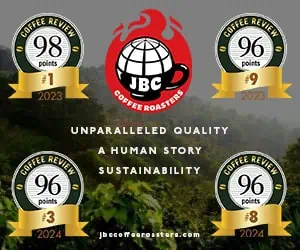LATEST REVIEWS
We have published thousands of coffee reviews and espresso reviews since 1997. The reviews below appear in reverse chronological order by review date. Older reviews may no longer accurately reflect current versions of the same coffee. To search for a specific roaster, origin or coffee use the Advanced Search Function.
A somewhat darker-than-supermarket-norm roast style helps mute acidity and sweeten the profile. Virtually no top notes, but a smooth, sweet-toned bottom with an attractive pruny finish.
The aroma is slight but lively; the acidity is bright, classic and lightly assertive, remaining safely if precariously on the right side of sour. The bottom notes provide just enough ballast for the relatively buoyant acidity.
For a canned coffee, considerable aroma: full, complete, with a silky, slightly vanilla-toned sweetness that grows in power as the coffee cools. Enough acidity to keep the coffee from dying, and a solid if obvious bottom.
Herbal tones in the aroma turn spicy and fruity in the cup. The fruit nuances in the acidity lift the top of the profile and keep it light and shimmering all the way through to finish and aftertaste. Enough bottom for resonance.
The aroma is complete but fades quickly. The acidity is bright, clear, and classic, hovering on the edge of winy. Some resonance echoes under the acidity, but both pleasure and complexity are concentrated at the top of the profile.
Depending on whether your palate reads the fermented notes as pleasantly fruity or disagreeably cloying, you could love or loath this coffee. If you think you might love it, ignore the rating, which deducts for the ferment. Under the impact of the dark roast the ferment turns lush, almost spicy. Displays the usual Indonesia virtue of solid body.
Hard, high notes surprise in both aroma and cup, persisting into the aftertaste. But if you taste attentively the fundamental, Indonesian matrix of the coffee emerges beneath the sharpness: rich, subtly low-toned, balanced, with some tones that even could be called chocolate. In the first round of cupping the sharp notes seemed to energize the coffee; in the second they just tasted sharp.
Dark fruit (prune?) tones complicate a solid, balanced, dark-roast character. Some carbon at the top of the profile, but good Indonesia richness underneath. The carbon dominates in the aftertaste.
First pungent then complex, the aroma is full of intrigue. We get a bit less in the cup, but given the darkness of the roast what remains is still impressive: enough acidity to keep the body lively, and generally an admirable balance between the qualities of the coffee and the impact of the roast.
This ingratiating dark roast comes straight at us, forgoing drama and intrigue. Not much Sumatra-style resonance behind its first sweet-pungent impression, but balanced and pleasing.
Extends from a deep, rich bottom to acidy, wine-elevated notes at the top. The usual Starbucks carbon tones are pleasantly lost in the expansive complexity of the coffee until the aftertaste, when they surface after the rest of the profile has passed into memory.
Some winy notes flirt from inside the dark-roast pungency. Otherwise an unremarkable but solid dark-roast coffee: balanced, without sharpness, and nearly carbon-free.
A model Mandheling: Low-toned, heavy-bodied, balanced, mouth-filling. Some carbon, but buffered by depth and richness. Enough acidity makes it through the roast to keep the deep bottom of the coffee from sagging into boredom.
This rich, deeply dimensioned, complex version of the great Guatemala profile happily combines clear, wine-toned acidity with satisfying dark-roast pungency. I even detected a hint of the famous Antigua smokiness smoldering somewhere inside the pungency.
Spicy, perhaps smoky tones enliven the rich top notes of the aroma and carry into the cup. Surprisingly clear acidity, fine body, long finish, superb aftertaste.
I wouldn't have expected a coffee so subtle to stand up to a dark roast so well. The roast only slightly mutes the heady floral tones of the aroma, while the acidity in tantalizing Yirgacheffe fashion hovers between flower and fruit. The body is hardly robust, but substantial enough to support the top notes. Only a trace of carbon.
Pungent, chocolate notes enliven the aroma, but in the cup burned tones dominate. The body is decent, but in the aftertaste the carbon prevails completely.
The high-pitched fruit and vanilla tones in the aroma deepen to herbal wildness in the cup, then to hints of ferment in the finish. Sufficient body but not much dimension.
Some wine tones survive the dark roast to complicate the acidity. Brought along to a dark roast slowly enough to spare us burned notes, but for a Kenya not a lot of body or dimension either. The pleasure would seem to be the paradox of understated acidity and dark-roast pungency.
Impressive complexity for such a dark-roasted coffee. Prune and vanilla tones grace the aroma, while a fruit-nuanced acidity dominates in the cup. As the coffee cools suggestions of ferment surface in the fruity acidity.










